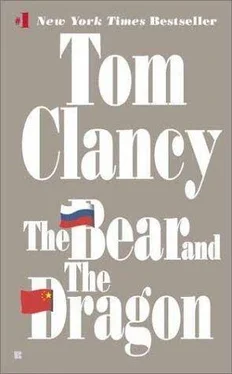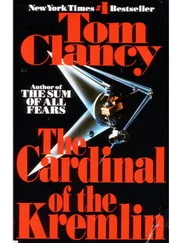Tom Clancy - The Bear and the Dragon
Здесь есть возможность читать онлайн «Tom Clancy - The Bear and the Dragon» весь текст электронной книги совершенно бесплатно (целиком полную версию без сокращений). В некоторых случаях можно слушать аудио, скачать через торрент в формате fb2 и присутствует краткое содержание. Год выпуска: 2001, ISBN: 2001, Жанр: Триллер, на английском языке. Описание произведения, (предисловие) а так же отзывы посетителей доступны на портале библиотеки ЛибКат.
- Название:The Bear and the Dragon
- Автор:
- Жанр:
- Год:2001
- ISBN:780425180969
- Рейтинг книги:3 / 5. Голосов: 1
-
Избранное:Добавить в избранное
- Отзывы:
-
Ваша оценка:
- 60
- 1
- 2
- 3
- 4
- 5
The Bear and the Dragon: краткое содержание, описание и аннотация
Предлагаем к чтению аннотацию, описание, краткое содержание или предисловие (зависит от того, что написал сам автор книги «The Bear and the Dragon»). Если вы не нашли необходимую информацию о книге — напишите в комментариях, мы постараемся отыскать её.
The Bear and the Dragon — читать онлайн бесплатно полную книгу (весь текст) целиком
Ниже представлен текст книги, разбитый по страницам. Система сохранения места последней прочитанной страницы, позволяет с удобством читать онлайн бесплатно книгу «The Bear and the Dragon», без необходимости каждый раз заново искать на чём Вы остановились. Поставьте закладку, и сможете в любой момент перейти на страницу, на которой закончили чтение.
Интервал:
Закладка:
“EAGLE LEAD, FALCON LEAD. The CLOVERLEAF is toast, and we are RTB, over.”
Boyle could do little more than shake his head. “Roger, FALCON. Well done, Captain.”
“Roger, thank you, sir. Out.” The Apaches formed up and headed northwest to their base to refuel and rearm for the next mission. Below, he could see the First Brigade, blown through the gap in Chinese lines, heading southeast into the Chinese logistics area.
Task Force 77 had been holding station east of the Formosa Strait until receiving orders to race west. The various Air Bosses had word that one of their submarines had eliminated a Chinese boomer and fast-attack submarine, which was fine with them, and probably just peachy for the task force commander. Now it was their job to go after the People’s Liberation Army Navy, which, they all agreed, was a hell of a name for a maritime armed force. The first aircraft to go off, behind the F-14Ds flying barrier combat air patrol, or BARCAP, for the Task Force, were the E-2C Hawkeye radar aircraft, the Navy’s two-engine prop-driven mini-AWACS. These were tasked to finding targets for the shooters, mainly F/A-18 Hornets.
This was to be a complex operation. The Task Force had three SSNs assigned to “sanitize” the area of ChiComm submarines. The Task Force commander seemed especially concerned with the possibility of a Chinese diesel-powered SSK punching a hole in one of his ships, but that was not an immediate concern for the airmen, unless they could find one tied alongside the pier.
The only real problem was target identification. There was ample commercial shipping in the area, and they had orders to leave that entirely alone, even ships flying the PRC flag. Anything with a SAM radar would be engaged beyond visual range. Otherwise, a pilot had to have eyeballs on the target before loosing a weapon. Of weapons they had plenty, and ships were fragile targets as far as missiles and thousand-pound bombs were concerned. The overall target was the PLAN South Sea Fleet, based at Guangszhou (better known to Westerners as Canton). The naval base there was well-sited for attack, though it was defended by surface-to-air missile batteries and some flak.
The F-14s on the lead were guided to aerial targets by the Hawkeyes. Again since there was commercial air traffic in the sky, the fighter pilots had to close to visual range for a positive ID of their targets. This could be dangerous, but there was no avoiding it.
What the Navy pilots didn’t know was that the Chinese knew the electronic signature of the APD-138 radar on the E-2Cs, and therefore they also knew that something was coming. Fully a hundred Chinese fighters scrambled into the air and set up their own combat air patrol over their East Coast. The Hawkeyes spotted that and radioed a warning to the advancing fighters, setting the stage for a massive air engagement in the predawn darkness.
There was no elegant way to go about it. Two squadrons of Tomcats, twenty-four in all, led the strike force. Each carried four AIM-54C Phoenix missiles, plus four AIM-9X Sidewinders, The Phoenixes were old-nearly fifteen years old for some of them, and in some cases the solid-fuel motor bodies were developing cracks that would soon become apparent. They had a theoretical range of over a hundred miles, however, and that made them useful things to hang on one’s airframe.
The Hawkeye crews had orders to make careful determination of what was a duck and what was a goose, but it was agreed quickly that two or more aircraft flying in close formation were not Airbuses full of civilian passengers, and the Tomcats were authorized to shoot a full hundred miles off the Chinese mainland. The first salvo was composed of forty-eight. Of these, six self-destructed within five hundred yards of their launching aircraft, to the displeased surprise of the pilots involved. The remaining forty-two streaked upward in a ballistic path to a height of over a hundred thousand feet before tipping over at Mach-5 speed and switching on their millimeter-band Doppler homing radars. By the end of their flight, their motors were burned out, and they did not leave the smoke trail that pilots look for. Thus, though the Chinese pilots knew that they’d been illuminated, they couldn’t see the danger coming, and therefore could not see anything to evade. The forty-two Phoenixes started going off in their formations, and the only survivors were those who broke into radical turns when they saw the first warheads go off. All in all, the forty-eight launches resulted in thirty-two kills. The surviving Chinese pilots were shaken but also enraged. As one man, they turned east and lit up their search radars, looking for targets for their own air-to-air missiles. These they found, but beyond range of their weapons. The senior officer surviving the initial attack ordered them to go to afterburner and streak east, and at a range of sixty miles, they fired off their PL-10 radar-guided air-to-air missiles. These were a copy of the Italian Aspide, in turn a copy of the old American AIM-7E Sparrow. To track a target, they required that the launching aircraft keep itself and its radar pointed at the target. In this case, the Americans were heading in as well, with their own radars emitting, and what happened was a great game of chicken, with the fighter pilots on either side unwilling to turn and run-and besides, they all figured that to do so merely guaranteed one’s death. And so the race was between airplanes and missiles, but the PL-10 had a speed of Mach 4 against the Phoenix’s Mach 5.
Back on the Hawkeyes, the crewmen kept track of the engagement. Both the aircraft and the streaking missiles were visible on the scopes, and there was a collective holding of breath for this one.
The Phoenixes hit first, killing thirty-one more PLAAF fighters, and also turning off their radars rather abruptly. That made some of their missiles “go dumb,” but not all, and the six Chinese fighters that survived the second Phoenix barrage found themselves illuminating targets for a total of thirty-nine PL-10s, which angled for only four Tomcats.
The American pilots affected by this saw them coming, and the feeling wasn’t particularly pleasant. Each went to afterburner and dove for the deck, loosing every bit of chaff and flares he had in his protection pods, plus turning the jamming pods up to max power. One got clean away. Another lost most of them in the chaff, where the Chinese missiles exploded like fireworks in his wake, but one of the F-14s had nineteen missiles chasing him alone, and there was no avoiding them all. The third missile got close enough to trigger its warhead, and then nine more, and the Tomcat was reduced to chaff itself, along with its two-man crew. That left one Navy fighter whose radar-intercept officer ejected safely, though the pilot did not.
The remaining Tomcats continued to bore in. They were out of Phoenix missiles now, and closed to continue the engagement with Sidewinders. Losing comrades did nothing more than anger them for the moment, and this time it was the Chinese who turned back and headed for their coast, chased by a cloud of heat-seeking missiles.
This bar fight had the effect of clearing the way for the strike force. The PLAN base had twelve piers with ships alongside, and the United States Navy went after its Chinese counterpart-as usually happened, on the principle that in war people invariably kill those most like themselves before going after the different ones.
The first to draw the wrath of the Hornets were the submarines. They were mainly old Romeo-class diesel boats, long past whatever prime they’d once had. They were mainly rafted in pairs, and the Hornet drivers struck at them with Skippers and SLAMs. The former was a thousand-pound bomb with a rudimentary guidance package attached, plus a rocket motor taken off obsolete missiles, and they proved adequate to the task. The pilots tried to guide them between the rafted submarines, so as to kill two with a single weapon, and that worked in three out of five attempts. SLAM was a land-attack version of the Harpoon anti-ship missile, and these were directed at the port and maintenance facilities without which a naval base is just a cluttered beach. The damage done looked impressive on the videotapes. Other aircraft tasked to a mission called IRON HAND sought out Chinese missile and flak batteries, and engaged those at safe distance with HARM anti-radiation missiles which sought out and destroyed acquisition and illumination radars with high reliability.
Читать дальшеИнтервал:
Закладка:
Похожие книги на «The Bear and the Dragon»
Представляем Вашему вниманию похожие книги на «The Bear and the Dragon» списком для выбора. Мы отобрали схожую по названию и смыслу литературу в надежде предоставить читателям больше вариантов отыскать новые, интересные, ещё непрочитанные произведения.
Обсуждение, отзывы о книге «The Bear and the Dragon» и просто собственные мнения читателей. Оставьте ваши комментарии, напишите, что Вы думаете о произведении, его смысле или главных героях. Укажите что конкретно понравилось, а что нет, и почему Вы так считаете.






![Александр Ирвин - Tom Clancy’s The Division 2. Фальшивый рассвет [litres]](/books/417744/aleksandr-irvin-tom-clancy-s-the-division-2-falsh-thumb.webp)




